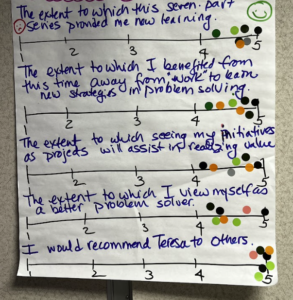
“Teresa had high energy, loads of examples, practical advise, and interactive learning activities. It was fun, informative and immediately useful.”
Creativity Tools and Techniques for Project Managers
September 18, 2024
Creative Problem Solving (CPS) is a structured process for generating and selecting ideas to address a challenge or to exploit an opportunity. CPS is most powerful if you want to go beyond conventional thinking and arrive at creative (novel and useful) ideas and solutions.
Creative Problem Solving (CPS) begins with two assumptions:
- Everyone is creative in some way toward problem solving*
- Creative skills can be learned and enhanced
*FourSight helps to reveal your individual and team preferences toward problem solving.
Alex Osborn first developed CPS in the 1940s, along with the term “brainstorming.” Together with Sid Parnes, he developed the Osborn-Parnes Creative Problem Solving Process.
At the crux of CPS is the dynamic balance and use of divergent and convergent thinking tools. Diverging focuses on generating ideas and options whereas converging focuses on evaluating and selecting from among developed ideas and options.
Through the alternating phases of divergent thinking (generating options) and convergent thinking (evaluating options) – and the tools that support them, CPS provides a way to manage the most detrimental opponents of creative thinking, namely premature or inappropriate judgement. Perhaps the greatest benefit of Creative Problem Solving is that it is universally understood, applicable across industries and cultures and can be developed in any individual.
Creative Problem Solving (CPS) is rooted in four core principles:
- Honor the dynamic balance between divergent and convergent thinking
- Reframe problems and opportunities to invite ideas
- Defer or suspend judgment…until later.
- Focus on “Yes, and” rather than “No, but.”
